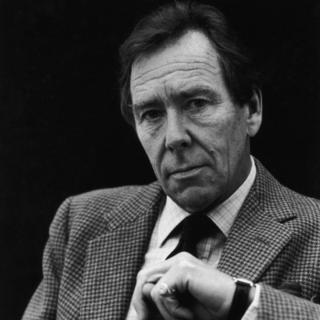 Lord Snowdon was a talented film maker and photographer whose marriage to Princess Margaret fed the gossip columns for over a decade.
Lord Snowdon was a talented film maker and photographer whose marriage to Princess Margaret fed the gossip columns for over a decade.
His career was punctuated by lurid tales of extra-marital affairs, alcohol and drugs, but throughout it all he maintained a close contact with the Royal Family.
His body of photographic work featured the cream of British society, although he was usually dismissive about his work.
He was most proud of the stunning aviary he helped design for London Zoo.
He was born Anthony Charles Robert Armstrong-Jones on 7 March 1930, into a family of minor gentry.
His father, Ronald, was a barrister while his mother, society beauty Anne Messel, later became Countess of Rosse, following her divorce from his father.
In his teens, he contracted polio and had to lie flat on his back for a year. It left him with a permanent limp.
But visits by such luminaries as Noel Coward and Marlene Dietrich, arranged by his uncle, the theatre designer Oliver Messel, helped alleviate the boredom.
He was educated at Eton, where his passion for photography began. He went on to Jesus College, Cambridge, and was cox of the victorious eight in the 1950 Boat Race.
He never completed his course on architecture, and at 21 took up photography as a career, setting up a studio of his own in London.
It was his flair for taking less formal photographs that earned him the commission, in 1956, for the 21st birthday pictures of the Duke of Kent.
Later he was invited to Buckingham Palace to photograph the Prince of Wales and other members of the Royal Family, including Princess Margaret.
Unlike some photographers, he did not set out to create a rapport with his subjects.
“I don’t want people to feel at ease,” he once said. “You want a bit of an edge. ”
His engagement to Princess Margaret was announced in 1960.
At the time there had been no recent precedent for anyone so near to the throne marrying outside the ranks of royalty or the British peerage.
The wedding took place on 6 May 1960, and after a honeymoon tour of the Caribbean in the royal yacht Britannia, the young couple moved into Kensington Palace.
Early in 1961 Armstrong-Jones was raised to the peerage as Lord Snowdon, and he took his seat in the House of Lords a year later. A son, David, Viscount Linley, was born in 1961, and their daughter, Lady Sarah Armstrong-Jones, three years later.
In 1963 the Queen made him Constable of Caernarvon Castle, and as such he took a leading part in the arrangements for the investiture of the Prince of Wales in 1969.
He was scathing about the ceremonial surrounding the event, claiming that most of the procedures used were “completely bogus”.
Princess Margaret and Lord Snowdon went to Jamaica together in 1962, when the princess represented the Queen at the independence celebrations, and they made an official visit to the United States in 1964.
In the early years of their marriage, he and Princess Margaret were treated almost as Hollywood stars. The press relished incidents in which the Snowdons donned leather jackets and raced motorbikes along London’s North Circular Road.
They consorted with celebrities of the day, and provided a marked contrast to the more conservative Queen and Prince Philip.
But the marriage quickly experienced the sort of difficulties that were destined to plague royal relationships over the following 20 years.
Snowdon’s womanising was part of the reason for the break-up. A natural charmer, he had a string of relationships throughout his life and seemed incapable of remaining faithful.
One close friend was quoted in a biography of the earl as saying: “If it moves, he’ll have it. ”
Margaret’s own predilection for late-night partying, and the desire of both of them to be the centre of attention, also fuelled the breakdown.
By then, Snowdon had embarked on a varied professional career – acting as adviser to the Council of Industrial Design, and working for various publications, including the Sunday Times.
The aviary he helped design for London Zoo opened in 1964. It was regarded as cutting-edge in its use of new materials, providing the maximum amount of space for birds to fly.
He helped to make several television documentaries. The first, Don’t Count the Candles, from 1968, was about old age and won seven international awards.
In 1975 he directed two programmes in BBC television’s Explorers series, and in 1981 he presented two programmes on photography, Snowdon on Camera, for which he was nominated for a Bafta Award.
Snowdon designed an electrically powered wheelchair, called the Chairmobile.
It was during a debate on the mobility of people with physical disabilities that he had made his maiden speech in the Lords in April 1974.
In March 1976, it was finally announced that he and Princess Margaret would live apart.
When Margaret had a relationship with Roddy Llewellyn, Snowdon was able to play the part, though not very convincingly, of the cuckolded husband, and the divorce became final in 1978.
Snowdon always refused to speak about the marriage but he regularly saw the children and continued to photograph the Royal Family.
In December 1978, he was married again, to Lucy Lindsay-Hogg, a researcher on a BBC television series on which he was working. They had a daughter, Frances, the following July.
In June 1980 Snowdon started an award scheme for disabled students. The money for it came from the reproduction fees he had received over 20 years from his royal photographs.
The following year the Snowdon Council was formed, of which he was president. It comprised 12 members co-ordinating a dozen different bodies concerned with helping disabled people.
Also in 1981 a compromise was reached in his long-running row with Lord Aberconway, president of the Royal Horticultural Society, who had said that disabled visitors to the Chelsea Flower Show were not encouraged.
It was agreed that guide dogs would be admitted, and a special garden was created for those with disabilities.






